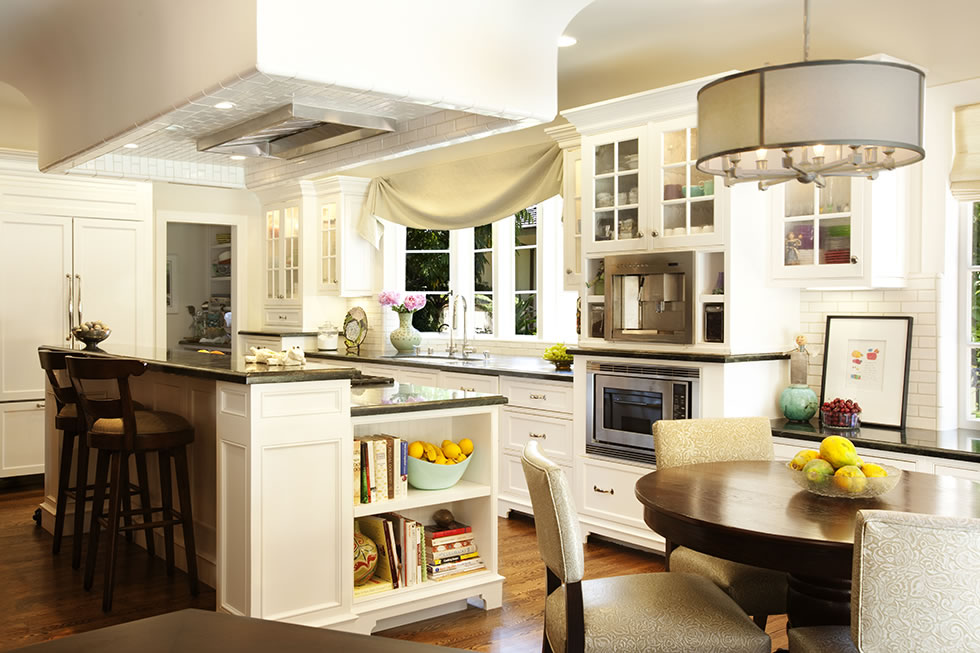
Kitchens remain the center of family living—a place to cook, eat, gather and entertain, and a prime reason many buyers gravitate to one house versus another. New appliances, sturdy cabinets, functional countertops and sensible layout may pique buyer interest. Similarly, a disappointing plan, poor lighting and dated equipment may crater a possible transaction, or conversely inspire a redo once buyers have moved in!
A prime concern when considering a kitchen project is that a full-blown overhaul can be expensive. On average nationwide, an upscale remodel hovers around the $126,000 mark, according to the 2018 Cost vs. Value Report from Remodeling magazine. Even a mid-range redo is pegged at an average $64,000. The reason for these significant costs is the cabinets and their installation and appliances, especially the latter with designer branding. Labor required for what’s needed behind the scenes—plumbing, electrical and heating—also ups the bottom line.
The good news, however, is that not everything has to be switched out. A few changes can enhance a room’s appearance and functionality—perhaps, new ergonomic pulls, fresh coats of paint, a new appliance or two, new light fixtures and nicer backsplashes.
Where do you start if you’ve never done this before? Kitchen designers generally suggest having a budget and adding 10 percent extra for what-if scenarios (i.e. a rotted subfloor); then deciding what might stay and what must go such as a hard-to-navigate traffic plan or dated palette. Then, you’re ready to seek some professional guidance; this is a tough room to do it yourself. Following are seven categories that reflect the most important functional and aesthetic decisions you’ll need to make to gain a kitchen that works well for you.
#1. Whom do you hire? Many prefer to work with a certified kitchen designer (CKD) who works either independently on their own or as a member of the staff of a kitchen showroom. But there are also skilled architects and competent contractors who’ve had years of experience in remodeling kitchens and have connections with all the subs needed–cabinetry and appliance stores and plumbing, electrical and HVAC tradespeople. The best way to find the right person is to ask friends, family and other home-related professionals for recommendations. But you can also enter a search engine key word phrase like "healthy kitchen interior designer" to find someone who focuses on what you’re most interested in, says Los Angeles designer Sarah Barnard of Sarah Barnard Design. Meet two or three pros in person, look at portfolios, discuss budget and share what you envision. Some may not take on minor jobs. Because kitchen remodels may take months, chemistry between home owners and their design professional is key. Once you’ve decided on the person, sign a detailed written contract. Consider asking an attorney to eyeball the document.
#2. How do you like to cook and store food? Deciding about appliances should be based on multiple factors: budget, how much you cook—and what, how much you store and the look desired. If you cook daily, you may be willing to spend more for a 5 or 6-burner gas range with big electric oven, plus a combination convection/microwave or second oven. If you’re only heating take-out, you may want to go with a smaller range and just a microwave. Your choice of a refrigerator/freezer requires a different set of criteria. Do you freeze a lot? Do you like having two doors for the refrigerator section? And how about your dishwasher? Do you entertain frequently? If so, you may need a delicate cycle and more racks to fit everything. Or do you entertain so often you want a second dishwasher? To gain more counter space, Barnard favors undercounter microwaves or oven drawers. Head to an appliance store, research online, or read guides such as "Consumer Reports." Warranties are also important since repairs may be costly. Compare warranties carefully.
#3. What cabinets are most durable and fit your style? This choice represents the most expensive part of your kitchen budget, sometimes hovering near the 60 percent mark, though more often at 40 percent to 50 percent. What makes the difference is whether you go stock, semi-custom or custom. At the lower end are stock—the dress equivalent of off the shelf like those from IKEA or Home Depot. Next up are semi-custom with some specialized detailing for more variety of styles and options. At the high end are custom, which means they were crafted to the exact size and finish you desire with higher quality materials on the outside and inside and better hinges. They also may resemble furniture with elaborate embellishments and have special stains or paint hues on doors and drawers. Barnard advises going with FSC-certified hardwoods without VOC finishes since they help make a room’s air healthier. But one key to having cabinets last is that they’re carefully installed to fit perfectly and align, which dictates that exact measurements be taken and professional installers be involved in the process.
#4. Which countertops and backsplashes will add chicness and workability? Look at kitchens through recent decades and certain countertops and backsplashes have ruled the roost. Decades ago, most went with a basic laminate or ceramic tile. Granite followed and was at first quite unusual and then became ubiquitous as less costly imports arrived. Home owners soon wanted something different, and they were on to quartz and quartzite, which were also considered more durable. Of course, marble has long been a favorite in upscale kitchens with the caveat that it might stain or crack. Slate has long appealed but can be expensive and also requires sealing. Stainless steel has been the provenance of many restaurant and experienced home chefs. For those who like to go the sustainable route, bamboo, recycled glass and concrete began to appeal, and still do. Besides deciding what best fits your aesthetic and budget, how you use your counter should be considered since some like quartz are more durable than others like soapstone. Backsplashes may be a place to go safe—with classic 3-inch by 6-inch white subway tiles—or be bold with the current trend of graphic hexagons and octagons.
#5. Do you have room to eat comfortably? Some kitchens may be too small to find a spot to eat in them, but most will offer some place or several—a windowed corner for a table and chairs—maybe, built in as a banquette, or a counter where stools can be arranged in a row like a favorite diner. The importance of trying to locate a spot is that you probably will end up using it in other ways—for friends to join you while you cook or for you to sit down to chop or take a break and read the newspaper or your mail. Keys to consider when planning are to place an eating counter at 36" off the floor and stools at about 24" off the floor. There always should be enough circulation area around a table and chairs. If the kitchen is very small, tie it visually to an adjacent space where a table can be placed, Barnard says. But also keep each a bit unique by not repeating all the same colors, materials or textures.
#6. How will you bring in the three essential light layers? Good illumination makes a big difference in how much you enjoy being in any room, but in a kitchen it’s important for performing tasks—cutting, chopping, stirring and setting out food if it’s a place where you entertain or at least set out a buffet. If the room has few windows to bring in natural light, the general rule of good lighting applies even more. Use the three layers: task lighting to perform chores, overall or general lighting to bathe the room in nice light, and ambient lighting for moods—romantic at night and workhorse by day. And think about all areas of the room. Placing lighting under cabinets, for example, helps increase productivity, reduce eye strain and improve overall visual appeal, says Barnard. LED bulbs cut energy costs and last longer and almost all come this way whether for a pendant or strips placed under cabinets. You may also want to install bulbs on dimmer switches, to vary how much light each emits.
#7. What materials are best for standing on? A kitchen is the room where you stand for long periods and that can certainly make legs weary. The right flooring creates a difference for many reasons, including being a unifying design source for colors and patterns throughout the room. These days many home owners like the look of wood and there are good seals to help them wear well even in a room where there’s water. Or wood facsimiles in sustainable porcelain boards approximate the look of real wood. Other sustainable choices such as cork and bamboo are durable yet soft on feet. Some owners still prefer ceramic tiles despite their heaviness when standing atop them. The pattern and color of any choice and how it’s installed can make a room look longer or wider, which may be important. If keeping feet warm is also key, installing electric mats underneath should be considered early in the design process since certain choices like ceramic and stone work better with mats than others such as vinyl do. Repeating flooring in adjacent rooms will connect them seamlessly, Barnard says.
Parting advice. Kitchens make a huge difference in how much you enjoy your home as well as how it functions. "Our homes are not made up of ‘stuff’ but rather experiences," Barnard says. "Therefore, it’s important to choose wisely."
